So occasionally someone reaches out regarding servos for a long out of production model airplane. Since I've been a modeler +50 years and have got a fairly decent stash of yet to be built models, I'm almost never caught by surprise by these requests.
Anyway, a few months back a fellow name of Ben in South Florida wrote inquiring about servos. Didn't begin with specifying what model they were for. Instead, his focus was on servo motors because he's had some servos fail. And since it was late (nearly midnight and the long suffering Lynn was already in bed and had stopped calling for me to quit), I whipped off a quick response before shutting down and turning in.
His query . . .
Q. I read your info on the web and am very interested in buying your servos. Help me
understand if yours would be comparable to Blue Bird servos I have been using for years. I
know that they have a broad line and I asking a tough question given that. Guess I had
judged they offer a good value of coreless or brushless Japanese motors but maybe the rest
of their product is lacking? I’ve had a few suddenly die and that bothers me. BTW is a
three pole motor best used on small starter planes?
A. Whew, you just caught me before going to bed. Review this article; About RC servo motors, to begin. We'll chat further tomorrow.
Next morning, his response . . .
Q2. Hell of an article! Like your attitude as it supports The facts.
I’ve been buying a price point and attempting to find a brand that used a higher grade
motor with little price bump. Even Blue Bird who use to be very cheap have increased
prices. Think it is time for me to wise up and make a change.
Advice please: I am redoing a 66” Dragon Lady powered by a DLE 20. This plane flies every
week or two. Should I buy ProModeler for this 12# plane? If yes, which ones?
- As an aside, if a bald guy walks into a barbershop and asks if he needs a haircut, what do you suppose the answer will be? So of *course* he needs ProModeler servos! Anyway, my TL;DR response follows . . .
A2. I am familiar with the Dragon Lady 60 because I've had one, but with an OS 108. For yours, equipped with a heavier DLE20, I'd be happy with DS90DLHV on throttle and either DS130DLHV on flight controls, or if I flew it pretty hard, maybe the DS180DLHV instead.
Battery pack-wise the B2S2500.
Stock servo arms will work but for a $4, get a 5-pack of the PDRS101 heavy duty glass-filled nylon servo arms as they may be better suited - it depends.
- ProTip; as usual, clicking a link opens a new browser tab so you don't lose your place.

Then I got to thinking, I crashed my own Dragon Lady 60 back around 2010 when the peanut gallery shouted, 'Lower', during some inverted passes. Ever willing to please, I gave it a shot and they got their real wish (to see some mayhem). Yup, I scattered bits and bobs for 100 feet down the runway!
There was no thought regarding the possibility of repair and instead, the remains were harvested for salvageable gear (fuel tank and wheels) and immediately went into the burn barrel. I took home the undamaged (and reliable as an anvil) OS Max 1.08 with a skint head and muffler (but just cosmetic damage) plus my unhurt radio equipment (receivers are expensive so I always use foam receiver wraps and never stick the receiver to a sidewall with Velcro because my money doesn't grow on trees).
Anyway, because it's a good flying model (similar to another good flying model, a SIG Four-Star 60 and midway size-wise between the very fun to fly Great Planes Super Sportster 60 and the 90/120 version), when I poked around and found another on eBay, I bought it.
Unfortunately, +10 years later, I've still not gotten around to it - sigh. These are the specs;
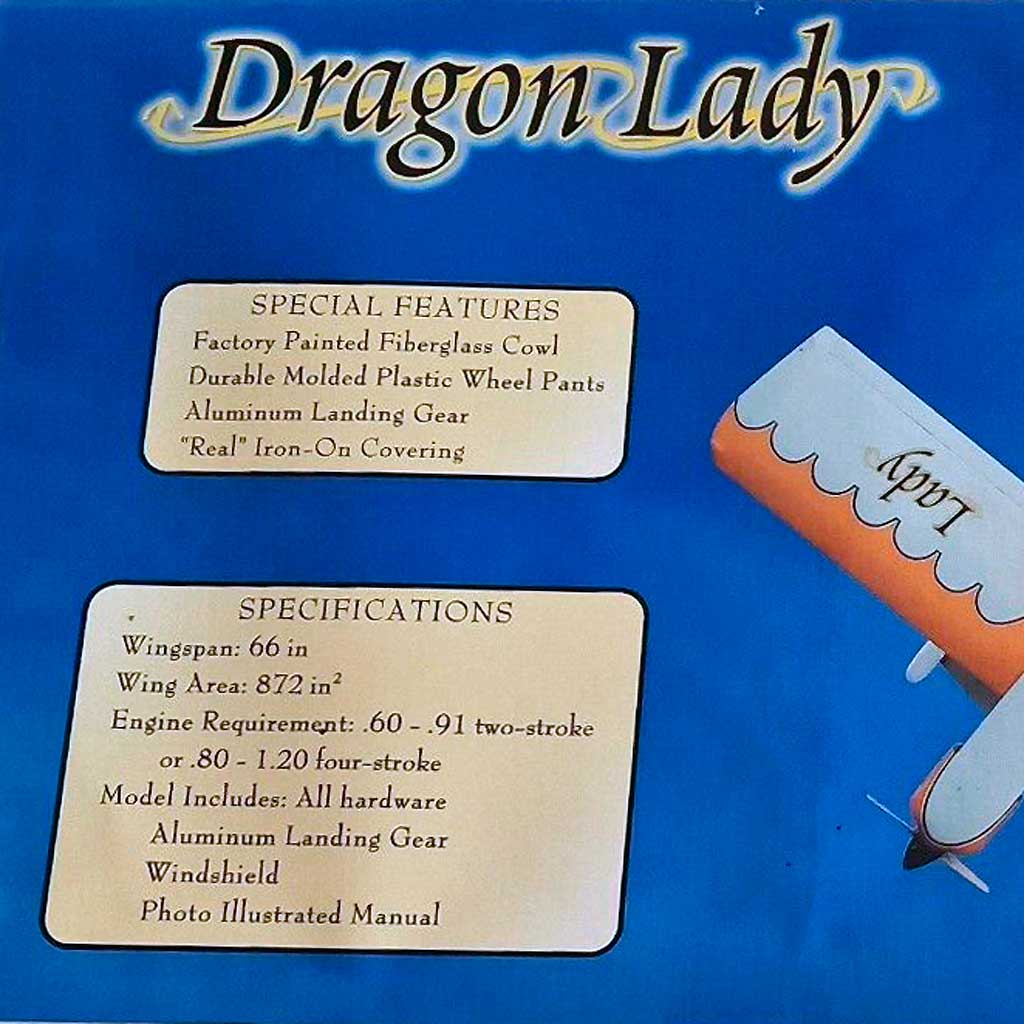

Point being, since I likely *will* get around to it one day, I've been pondering, when I do, what would I do different on the next go around? That, and would anybody care if I shared my thoughts? Well, facts are, if you poke around on eBay, you can still find the model for sale, both the ARF and the ARC version so this fact alone is reason enough to create a caseSTUDY.
Why can you still find them for sale? It's because Global Hobby (the importer but AKA Hobby Shack, a long established chain of west coast hobby shops) imported about a million of them. Why? Well, because it's a great flying model that's simple, tough, and did I mention it? It flies great! Means it was very popular. And I've noticed when they come up for sale, they don't hang around.
So here we go, another caseSTUDY where we yak about servo selection because the answer to which are the best servos for the Modeltech Dragon Lady 60 is . . . it depends! And note; everything I have to say about this model pretty much holds true for the SIG Four-Star 60 and both Great Planes Sportsters.

Running the numbers
First up, let's review what we're dealing with. The Dragon Lady 60 is a low wing sport model with open cockpit reminiscent of a between the wars tube and fabric aircraft, or post war homebuilt.
It's a model spanning 66" but with a wide cord resulting in a generous amount of wing area (listed as 872in²) and because he says it's 12lbs then that works out to 31oz/ft² a good figure for a sport model with a fat semi-symmetrical airfoil.
Note; the same holds for the more lightly built Sig Four Star-60, or the slightly larger Four-Star 120, or even the more substantially built Great Planes Sportster 60 or the 90/120 version.
Here's the math for calculating the wing loading;
- Convert 872in² to square feet so 872/144 = 6.05555ft° (remember, 12in x 12in = 144 in² so put that result into M+ of the calculator.)
- Convert 12lb to ounces by multiplying by 16oz/lb so 12lbsx16oz/lb = 192oz.
- Divide 192 by MR and you get 192/6.0555 = 31.7oz/ft²
. . . and you'll have to take it from me, but this is a decent wing loading for a sport model. My Dragon Lady 60 settled in nicely when landing without tip stalling. And because I know mine weighed 11lbs (glow engine, no ignition so figure 29oz/ft²) and I've probably landed mine about a million times (slight exaggeration), then believe me, the extra pound would make little to no difference, in my opinion.
So what do you get in the box? Typical Asian built balsa/light ply ARF covered in film (neither MonoKote nor Ultracote, something else - sigh).
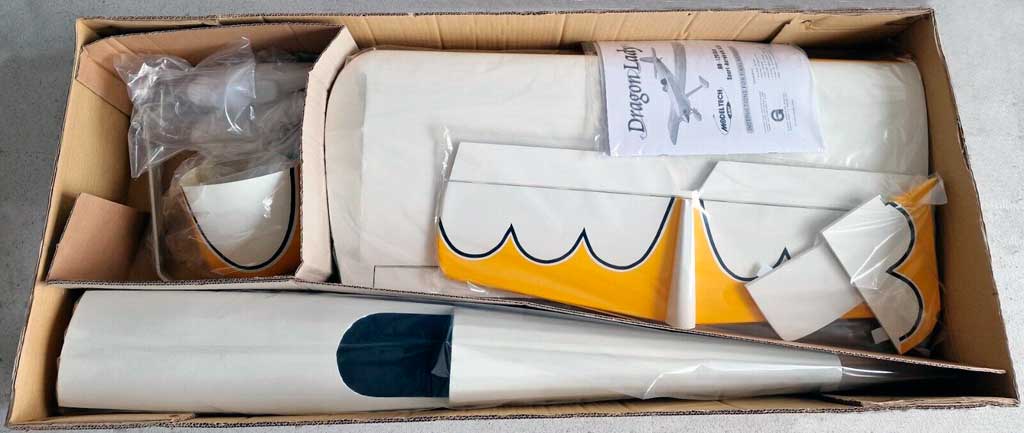

So when it comes to servos, you need to know what engine you're going to use because it'll affect what servos to select and more importantly, where you're going to install them. Why? It's 100% down to the weight of the engine package and power output. So the right answer regarding servo selection is . . . it depends on not just how you fly, but on engine selection. Let's discuss piloting, first, then discuss how engine choice matters.
How the way you fly affects the choice in servos:
3-pilots - sport pilot, expert pilot, plus the wild-and-crazy guy
In general, if you're a sport pilot and want the Dragon Lady 60 for early mornings or late afternoons after work flying, think fun and relaxed maneuvers, e.g. lazy eights, lots of circuits, touch-and-goes, maybe the occasional loop or roll, plus inverted flight, etc. then all you need to get are four ProModeler DS90DLHV servos, plus a B2S2500 battery pack, and call it done! Even the included servo arms are going to be fine.
This works out to three servos for flight controls (rudder, elevator, ailerons) plus throttle. On a scale of good, better, and best, think of these high quality 90oz-in DL-series servos (DLS) as plenty good enough for pretty much any sport pilot flying this model.
If you're an expert pilot, meaning you're probably going to fly it harder; think adding to the above list some snapping-maneuvers like snap rolls and Lomcevak (where the aircraft will rotate on all three axis performing three end-over-end negative-G tumbles, each tumble being at about 45° to the plane of the last and where the maneuver ends when the aircraft runs out of momentum and begins falling with enough speed for the airflow past the control surfaces to stop the tumbling), plus combat-maneuvers like split-S, stall turns.
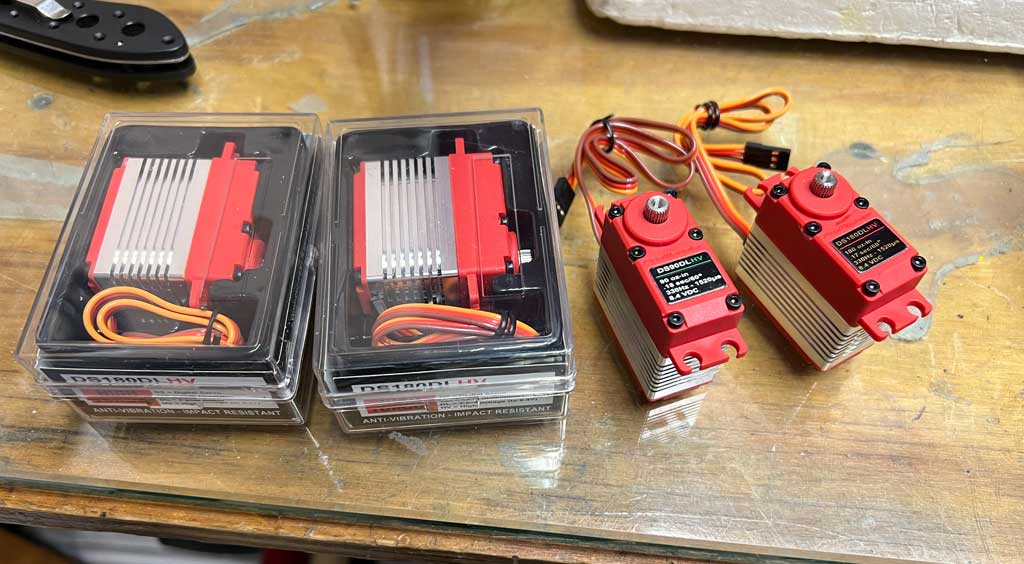
- Expert pilot selects ProModeler DS180DLHV for flight controls and DS90DLHV for throttle

Snapping maneuvers performed low are the hallmark of the real expert pilot because he has total control of the model at any altitude. Added to which, snap and combat maneuvers are both fun and relatively easy to master - but - require a bit more servo because they're being flown at higher airspeed.
Again, we turn to the DLS servos (there are 5 models ranging from 90-360oz-in and priced from $30-50 in $5 increments) where the recommendation is either the ProModeler DS130DLHV (130oz-in of torque) or maybe the slightly stronger ProModeler DS180DLHV servos on the flight controls plus DS90DLHV for throttle.
Note; the decision for the flight control servos being a judgement call to include engine selection (more later). And once again, the same B2S2500 battery pack will be fine.
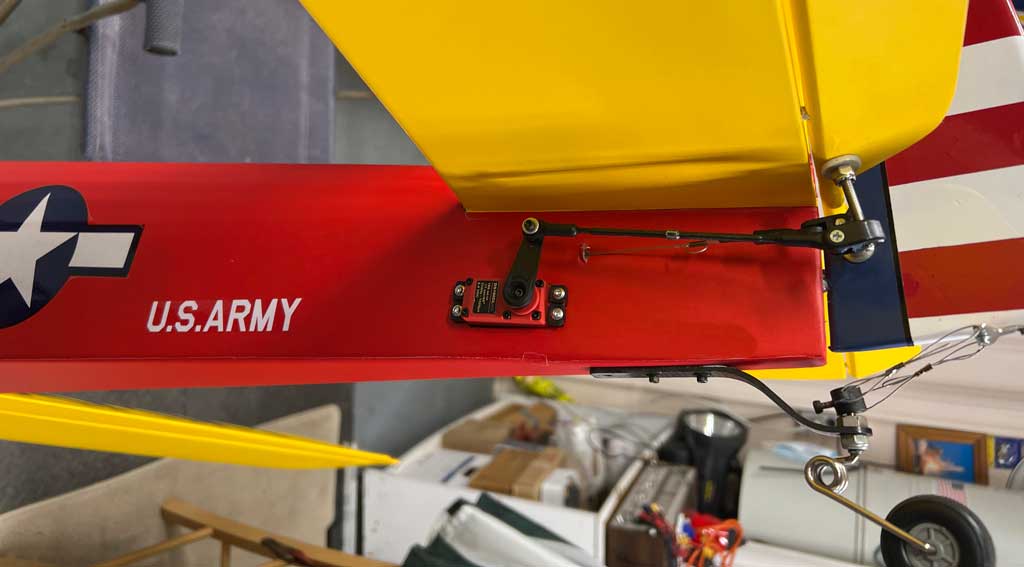
- Note the aft mounted elevator servo - remember to add a 12" extension when doing this

The wild and crazy guy is the pilot who thrives on adrenaline. Every maneuver the airframe is capable of is within his repertoire to include the above plus rolling circles down on the deck, slow rolls, Harrier rolls, and crazy maneuvers which have no name. This pilot flies with exuberance and a joie de vivre that is defined by a sheer exultation of spirit and he basically flies it like he stole it.
That, and because the throttle is wide open a lot of the time, then as a consequence of higher airspeed, he may need a touch more servo-torque. For this pilot, the recommendation is the DS180DLHV at a minimum, or maybe the DS270DLHV on flight controls, and still using the DS90DLHV for throttle.
And just as for the sport and expert pilot, once again the same B2S2500 battery pack will be fine. However, depending on his skill set, he *may* increase rudder-servo torque one notch to enhance power (for snapping). So figure going from a DS180 to a DS270, or from a DS270 to one DS360DLHV on rudder, instead. This, despite knowing it will add another $5 to his build costs.
This model is set up with pull-pull on rudder so a double-horn servo arm is used.
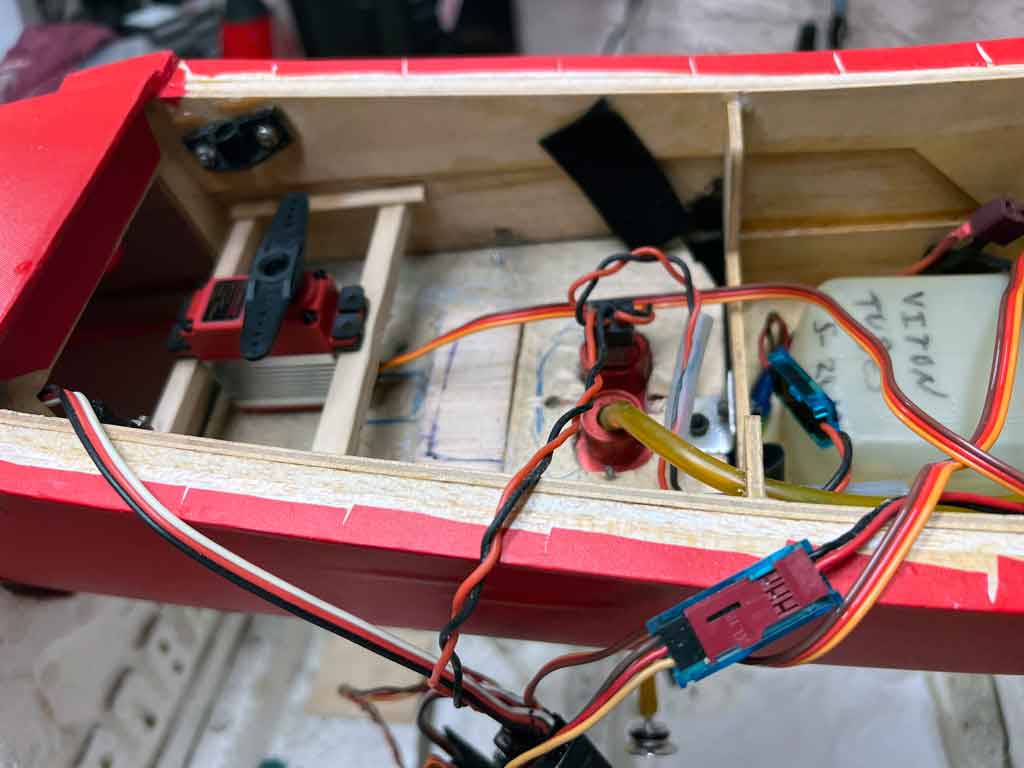
- Wing saddle area mounted rudder servo with double-horn servo arm for pull-pull cable

How the engine selection affects the choice and placement of the servos
My customer mentioned using a DLE20 - a baby gasser. This is a sweetheart of an engine. Bit heavy though because it carries the same weight for the ignition system as a significantly greater displacement and much more powerful 85cc engine like a DA85.
No, absolutely *not* saying a DA85 would make a good fit (it wouldn't) just observing that for its 20cc displacement, the DLE20 carries a significantly greater fraction of the total weight as ignition versus an 85cc displacement engine because the ignition module is about the exact same.
Major point being, with a heavier engine in the nose, you need to try and account for it with equipment placement so the model won't need the dead weight of lead to help balance. For this reason, you'll recall in the above photo of the elevator servo, my customer mounted it aft near the stabs.
This is a expert modeler's use of equipment to compensate for greater engine weight using equipment to help the weight and balance. He did it because the DLE20 weighs significantly more than engines commonly used when the model was initially released (like an OS MAX 1.20 four-stroke).
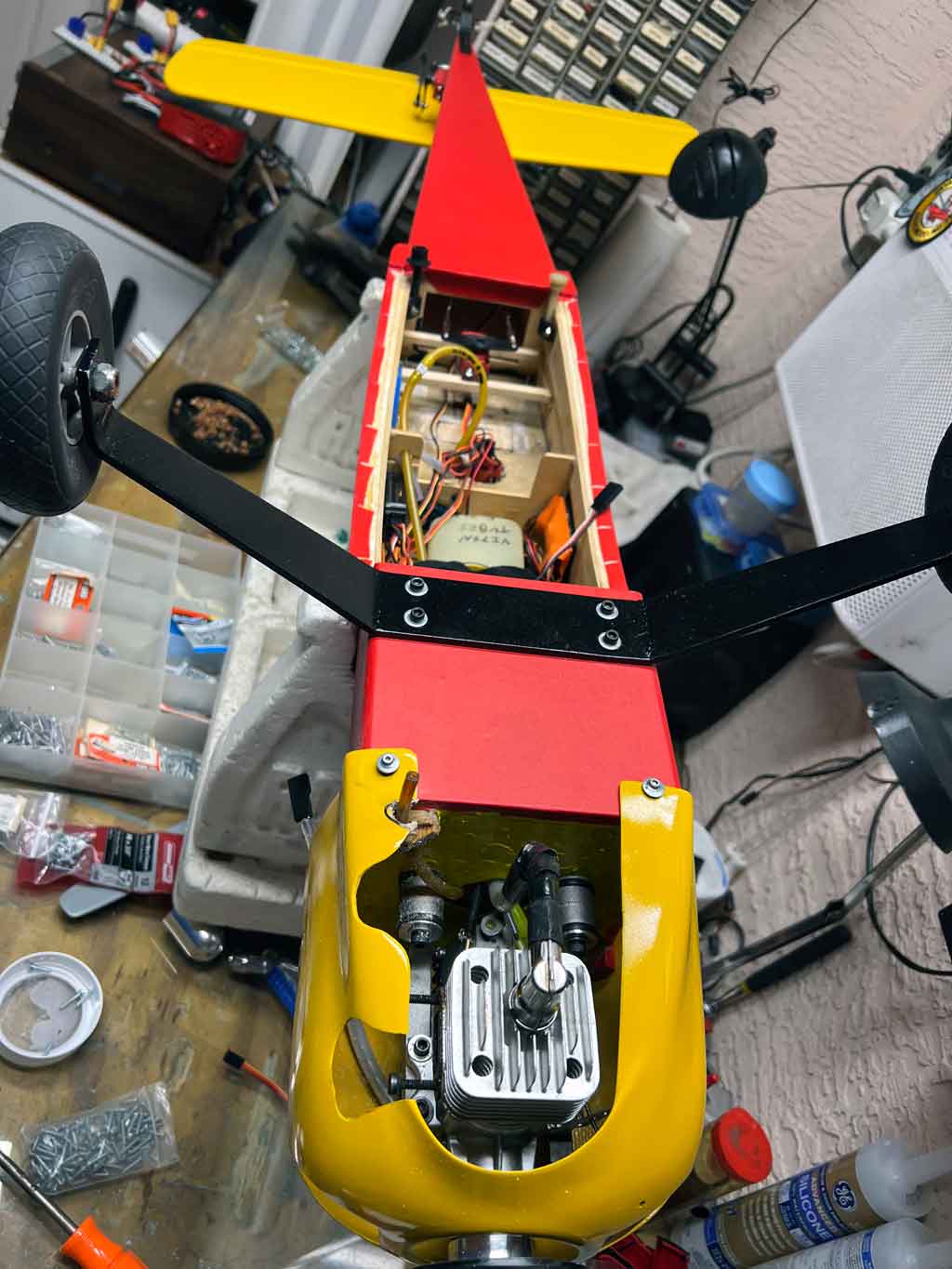
- The DLE20, a nifty baby gasser tucks right in and looks great - a clean installation!

So earlier I mentioned engine selection also affects the choice of servo. This is for two reasons, available power and weight. Higher power typically means higher airspeed, and higher weight means more mass to horse around. Since F=M*A (force equals mass times acceleration) then when you combine the two, more power (speed) and more weight, then the savvy pilot steps up one class in the servo department. E.g from DS130DLHV to DS180DLHV, understand? It's just a matter of wanting a little bit extra oomph from the servo, like perhaps when coming out of a high speed dive.
Battery pack consideration - LiIon vs. A123
So let's wrap this up with a brief discussion about the battery pack. I've been recommending the B2S2500 as the pack for all of these instances, the sport pilot, the expert, and wild and crazy guy. This is a LiIon pack making about 8.1-8.2V fresh off charge.
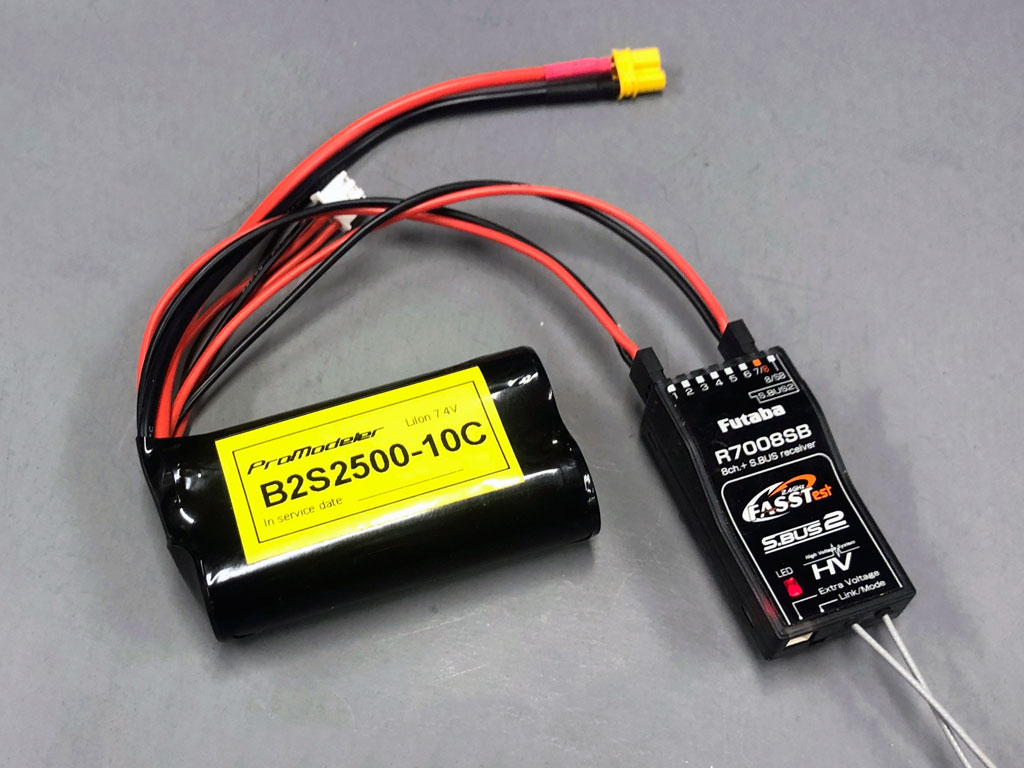
- Note ProModeler packs are built with multiple leads making it easy to add two switches

What changes the recommendation? Some guys prefer to live with LiFePO4 chemistry instead of LiIon because it's less critical and easier to live with. Examples of this are there's no requirement to put the pack at storage voltage after use, and they can be stored fully charged. We offer A123 packs (LiFePO4) in three capacities;
So this is a decision that's 100% down to convenience vs. performance. The downside of these A123 (or LFP) packs is they are 6.6V packs instead of +8V so it also means reduced performance from the servo. True for any servo, any brand because of physics. It just is.
Let's consult the performance chart for a DS180DLHV to suss out what the implications of this difference in voltage levels amounts to in the real world. And heads up, it's significant and can't be ignored and the solution every time is throw a higher rated servo at the problem. Means you may have to pony up an extra $20 for the four servos if you want the convenience of A123 packs versus LiIon packs. Which chemistry is better? Depends on what's important to you.
Me? I love how a honey-do that interferes with flying this weekend doesn't mean I need to discharge the flight pack because the safer chemistry means it can just sit there totally fine (unlike old school NiCds, these don't self discharge at an appreciable rate, even a year later, they're fine).
So for most of my models I use A123 packs. The exception? Serious 3D models where I need every oz-in the servo can develop in which case, then I opt to use the LiIons every time.
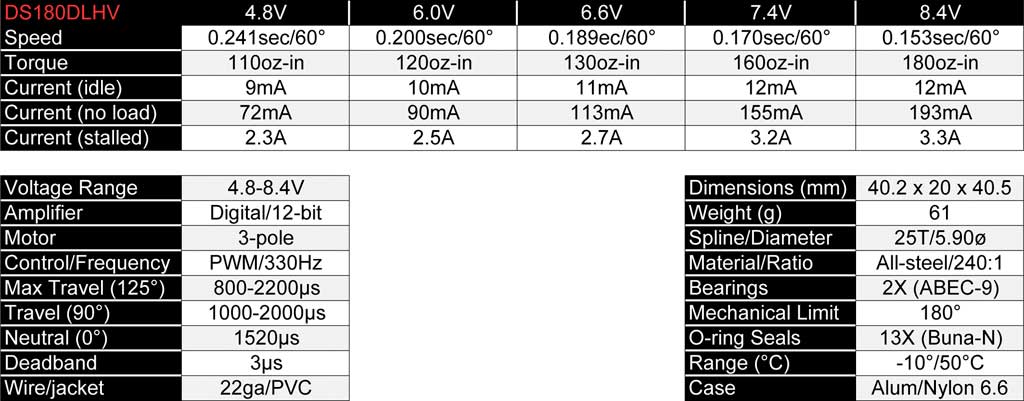

Note the DS180DLHV servo at 8.4V is rated to output 180oz-in (after all, you gotta put lipstick on the pig and tout the best numbers). Believe me, manufacturers are always going to show their product in the best light. The difference, however, is with ProModeler we tell you the good, the bad, and the ugly so when you make a decision, it's from the position of knowledge. Meaning, an informed decision.
So because reduced voltage *must* be taken into account when speccing your servos, the battery chemistry to be used is yet another factor to take into account when determining the best servos for your application.
Eyeballing the middle column (above), the one for 6.6V shows that the DS180 is going to be making 130oz-in instead of a 180oz-in. So a decent rule of thumb when using LFP packs (LiFePO4 are also known as A123 and/or LFP for Lithium-Irom-Phosphate) instead of LiIon, then step up a notch in terms of servo torque rating.
ProTip: don't confuse LiFePO4 with el cheapo packs featuring LiFe cells. There are similar but totally different chemistries - and one has cells encased in metal (better, e.g. more robust against dings and drops or mishandling) and the other features cells enveloped in delicate polymer. Any ding in one of those, even if you smooth it out so it doesn't show has permanently damaged the cell, which is bad juju. Heads up!
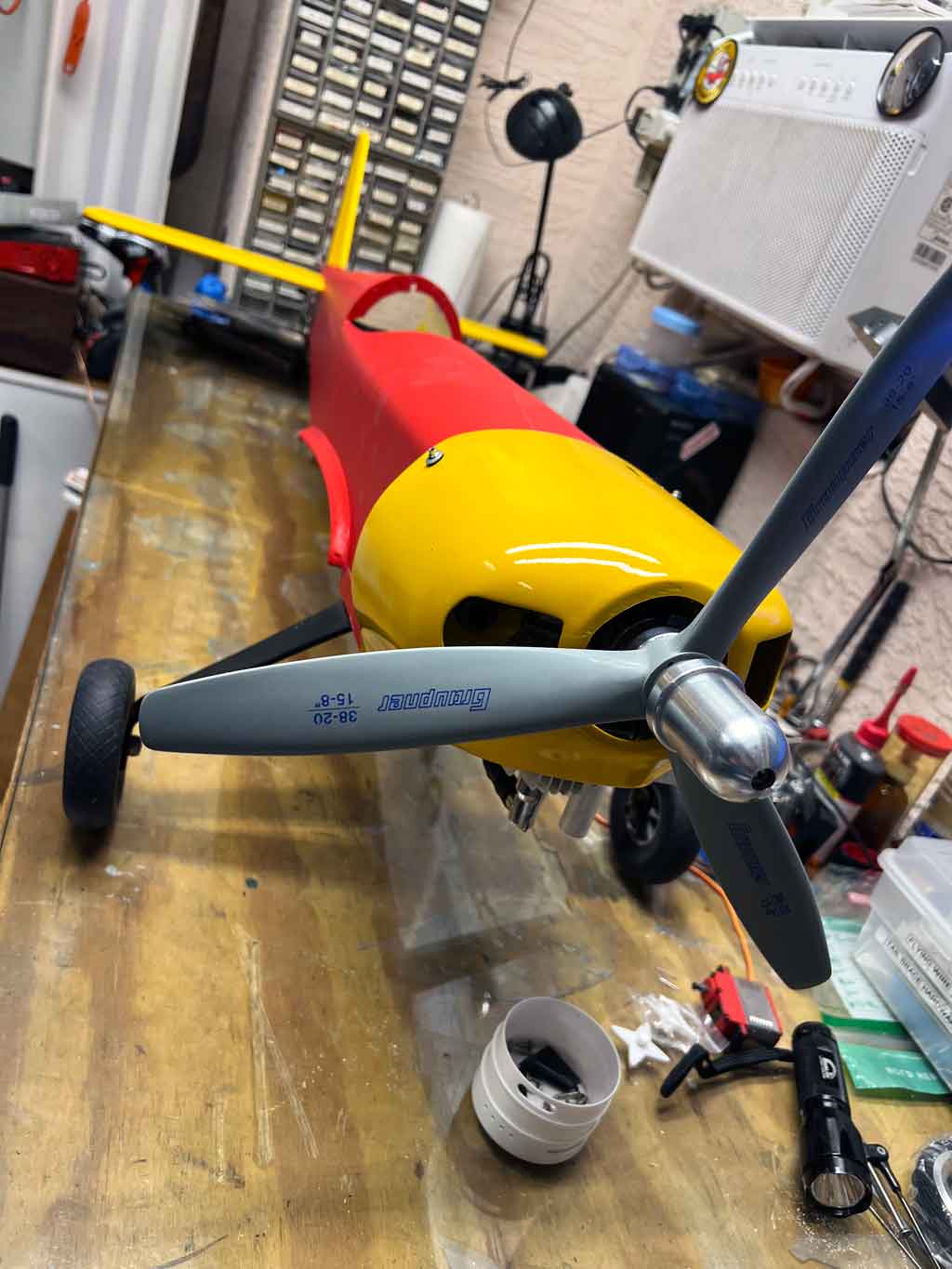
- Snazzy looking 3-blade prop with a red and yellow color scheme

So wrapping this up, we'll recap Dragon Lady 60 servo selection as follows;
- Sport Pilot: Four DS90DLHV plus a B2S2500 battery pack w/stock servo arms
- Expert Pilot: Three DS180DLHV, a DS90, B2S2500 pack, PDRS101/102 servo arms
- Wild & Crazy Pilot: Three DS270 plus a DS90, B2S2500 pack, PDRS101/102 servo arms
. . . and if you're running an A123 pack, then step up one notch torque-wise to make up for the reduced voltage. And if the engine is heavy, or especially powerful, then also consider stepping up another notch torque-wise, as well. This because there's no such being too rich, too thin, or having too much power!
Final thoughts. My customer's model - instead of being the yellow and white ARF like mine - was an ARC (Almost Ready to Cover). He finished his in red and yellow, instead. That, and instead of blue with yellow of between the wars Army aircraft, he went with red with yellow and put Army on it anyway! I think it looks great. Really makes for a standout model appearance-wise!
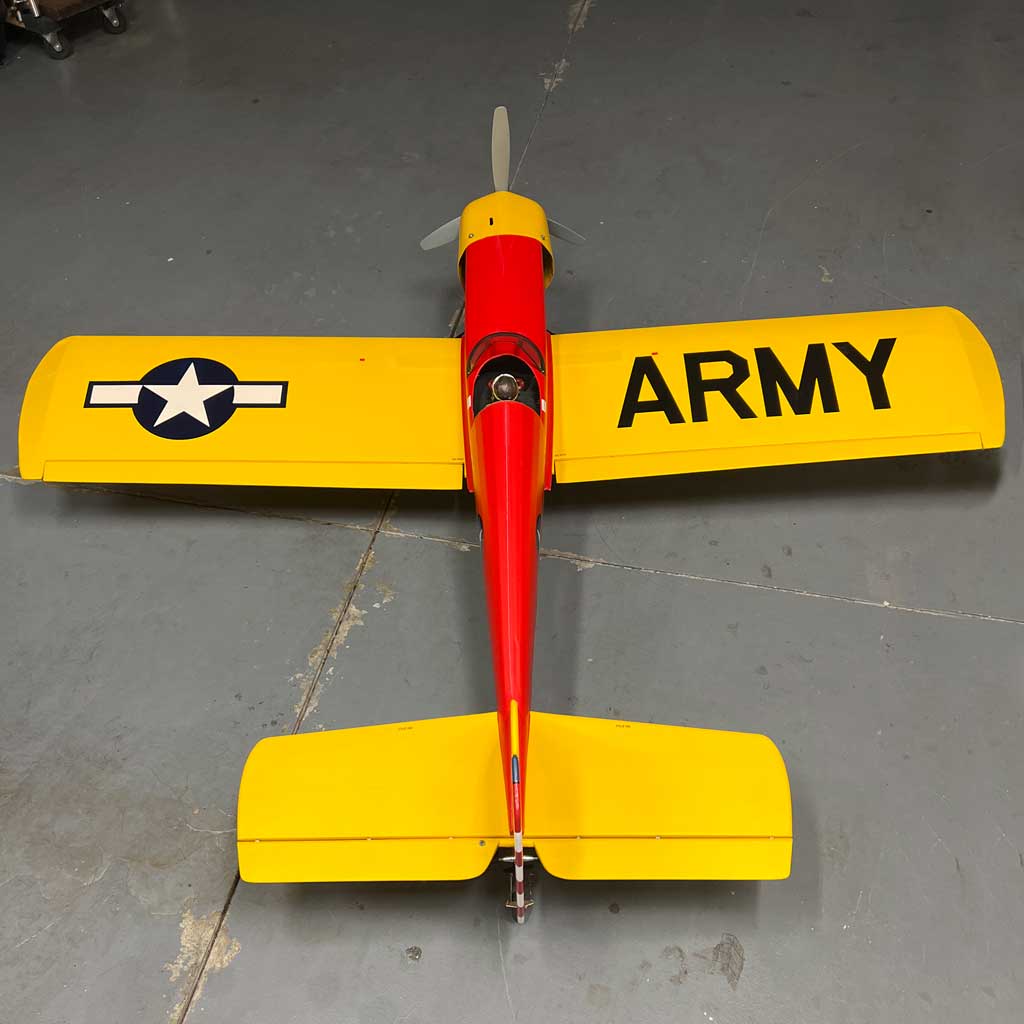

Still have questions? Call us at 407-302-3361 and we'll try to help you!